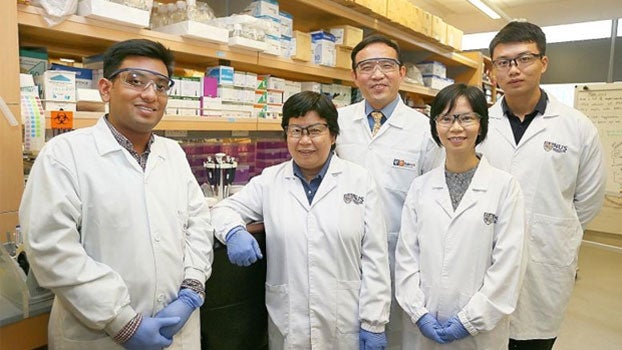SingHealth Institutions will NEVER ask you to transfer money over a call. If in doubt, call the 24/7 ScamShield helpline at 1799, or visit the ScamShield website at www.scamshield.gov.sg.

Dr Sudipto Bari, research fellow, Department of Haematology, SGH; Professor Christina Chai, head, Department of Pharmacy, NUS; Associate Professor William Hwang, medical director, Department of Haematology, SGH; Associate Professor Gigi Chiu, assistant head, Department of Pharmacy, NUS; and Dr Zhong Qixing, NUS. ST PHOTO: JONATHAN CHOO
More effective harvesting of stem cells in the umbilical cord may help in search for blood cancer cure
The search for a cure for blood cancers has received a boost, with new research by Singapore scientists shedding light on how stem cells can be more effectively used to treat diseases such as leukaemia.
The team said at a briefing yesterday that they have discovered a laboratory-synthesised chemical substance that can be used to increase the number of stem cells harvested from umbilical cords.
This will help overcome a current challenge of cell levels being too low to help patients recover quickly, they said.
This need for a quick recovery is to minimise the risk of bacterial, fungi or viral infections, said Associate Professor William Hwang, medical director of the National Cancer Centre Singapore, one of the researchers involved. Associated health care costs can also be reduced when a patient's recovery time is shortened, he added.
The other four researchers are from the National University of Singapore (NUS), Duke-NUS Medical School, and the Singapore General Hospital (SGH).
More than 200 patients in Singapore undergo such stem cell treatments every year for diseases such as blood cancers.
In general, stem cells are "elastic" cells, capable of regenerating and differentiating into various cell types in a person's body. For example, stem cells can be induced to become blood, bone and tendons, among other things.
When stem cells differentiate, they become progenitor cells, which are more specialised and have a shorter lifespan.
Those found in the bone marrow or peripheral blood are considered haematopoietic (blood-forming) progenitor cells.
These cells are slightly more specific, in that they regenerate to form cells that constitute blood - red blood cells, platelets and cells of the immune system. They also last for a shorter period of time. When it comes to treating blood cancers, stem cells and blood-forming progenitor cells are both injected into the patient.
After entering the bloodstream, the stem cells travel to the bone marrow and start to make new blood cells. This helps stimulate new bone marrow growth and restores the immune system.
These cells are usually harvested from either the umbilical cord, peripheral blood (bloodstream) or bone marrow. But there are challenges.
Because harvesting bone marrow stem cells involves an invasive procedure, there are few donors. As for peripheral blood, the cells collected usually have more immune cells. These cells could in turn attack the patient and cause side effects. Umbilical cord, however, is promising as it contains the highest number of undifferentiated stem cells but not high enough for rapid recovery in adult patients.
This results in the longest recovery time of more than 25 days in a patient who has undergone umbilical cord blood transplant, compared to the 14 days of recovery time from a peripheral blood transplant, and an 18-day recovery period from bone marrow transplant.
The researchers found that a laboratory-synthesised substance called C7 is able to expand the number of blood-forming stem cells in the umbilical cord through cell culture.
Said Prof Hwang, who is also a senior consultant at SGH's department of haematology: "There are patients who are unable to find a fully matched bone marrow or peripheral blood stem cells. For these patients, umbilical cord blood is the only source of grafts."
"Expanded umbilical cord blood (using C7) would be a life-saving option," he added.
The researchers said trials involving mice were encouraging, as they showed that the stem cells increased in numbers over time, and did not die. Clinical trials are expected to start in mid-2019. With support from industrial partners, Prof Hwang said he is optimistic that stem cell treatment could be available to patients within the next five years.
Contributed by
Keep Healthy With
© 2025 SingHealth Group. All Rights Reserved.




















